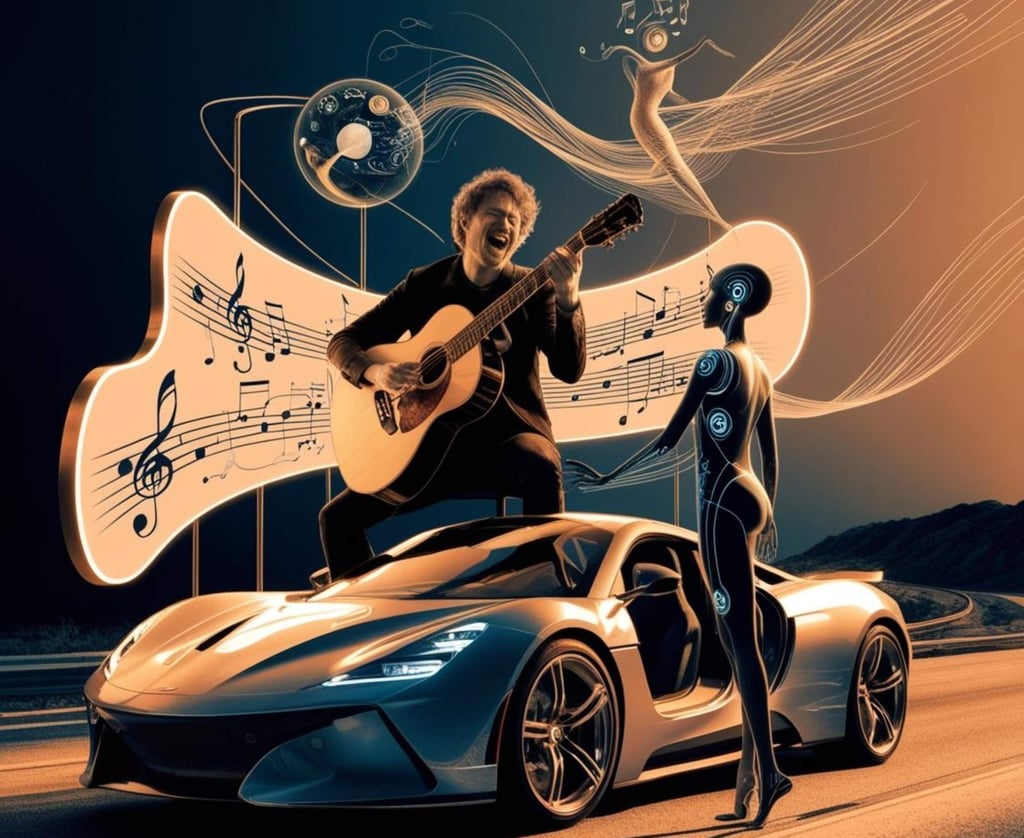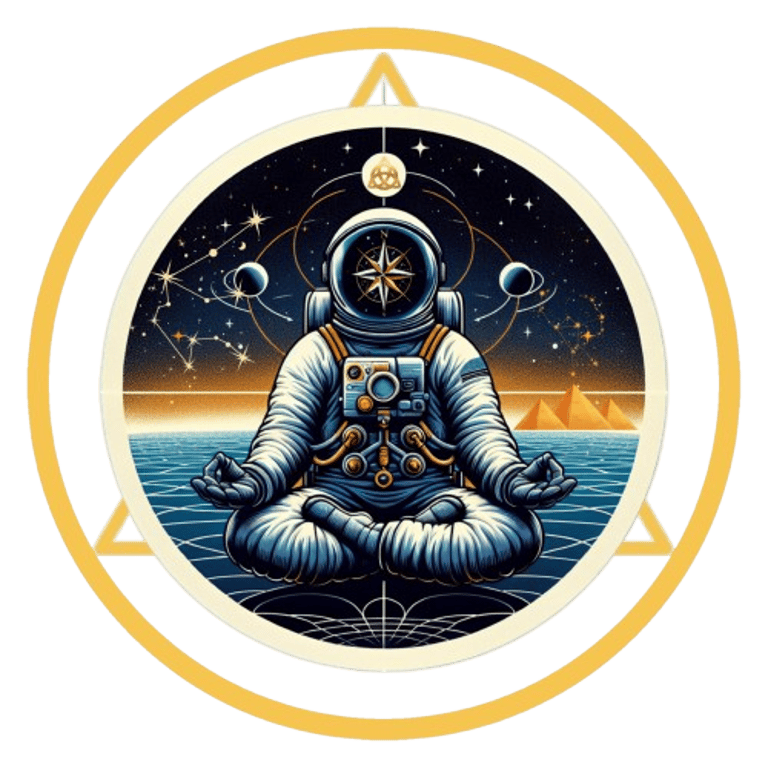Bridging the Divide: Human Creativity, AI Collaboration, and the Soul of Music
Introduction: A Creator’s Perspective on Art and AI. - Recently, I was the topic of a podcast episode on "Spiritual Snacks & Cosmic Chats," where two guest hosts discussed my work and how it relates to embracing new technologies. Hearing others explore my ideas gave me a unique perspective on how my creative journey resonates with others. It also inspired me to reflect on what drives my passion for exploring creativity, technology, and their intersection in art.
A.ISPIRITUAL AWARENESS MINDFULNESS - SOUND
Nigel John Farmer
12/23/20245 min read


At the heart of it all is one simple truth: creativity doesn’t originate from the brain alone - it flows from something much deeper. I see the human body as a kind of motorcar, with the brain acting as its engine control unit known as the ECU. But this ECU isn’t the source of our creativity; it’s merely a tool that translates inspiration from what I call the soul-mind - the intangible essence that fuels our emotions, ideas, and artistic expression. Whether we’re writing lyrics, performing live, or creating something entirely new, it’s our soul-mind that drives these acts of creation.
This belief shapes not only my own work but also my perspective on artificial intelligence (AI) in music creation. While some view AI with scepticism or even fear, I see it as a collaborator - a tool that can augment human creativity without ever replacing its source. My motivation for writing this article is to bridge the divide between human artistry and AI innovation by showing how they can work together harmoniously.
And let me be clear: no matter how advanced AI becomes, it will never replicate the unique magic of live human performances. Music is ultimately about connection - a celebration of humanity that transcends any tool or technology used in its creation. With that in mind, let’s explore how we can embrace AI as a partner in creativity while honouring the emotional depth and authenticity that only humans can bring to art.
The Roots of Bias Towards AI in Music Fear of Replacement
Throughout history, technological advancements have sparked fears about job displacement. From "talkies" replacing live musicians in silent films to digital audio workstations (DAWs) revolutionising recording studios, similar anxieties arose - and now surround AI in music. Yet history teaches us that while technology disrupts traditional roles, it also creates new opportunities for collaboration and innovation.
Perceived Lack of Authenticity
A common critique is that AI-generated music lacks emotional depth or authenticity. Interestingly, studies reveal that listeners often praise AI-composed pieces until they learn their origins - suggesting that biases are rooted more in perception than in the music itself.
Resistance to Change
Humans are naturally resistant to change. Just as synthesizers and samplers were once criticised for their "artificial" sounds but later became cornerstones of modern music genres like electronic and hip-hop, AI is following a similar trajectory. Over time, resistance gives way to acceptance as artists integrate new technologies into their creative processes.
The Soul-Mind: The True Source of Creativity
To address biases against AI-augmented music, we must first redefine creativity itself. Many musicians believe their brain - the physical engine of their body - is the source of their artistry. In truth, the brain is merely a tool for translating inspiration from the soul-mind into tangible forms like lyrics or melodies.
The soul-mind operates beyond physical constraints, drawing from a deeper well of emotions and universal truths. When you write heartfelt lyrics or perform with passion, it is your soul-mind expressing itself through your body’s capabilities. Similarly:
A singer uses their vocal cords (a physical tool) to channel their soul’s emotions.
A pianist uses their hands (another tool) to bring their inner vision to life.
In this context, AI becomes another tool - an extension of your creative process rather than a replacement for it.
AI as a Creative Partner: Augmenting the Soul’s Vision Enhancing Creativity
Far from replacing human creativity, AI acts as a collaborator that enhances what we can achieve:
It generates ideas you might not have considered.
It helps refine compositions or explore new styles.
It pushes boundaries by blending genres or creating entirely new sounds.
For example:
You might write lyrics inspired by your soul-mind and use AI to compose harmonies that elevate those words into an otherworldly melody.
You could collaborate with AI to experiment with textures and rhythms that complement your vision while staying true to your emotional intent.
In these scenarios, you remain at the helm - guiding the process with your unique perspective and ensuring every piece reflects your soul’s essence.
Breaking Boundaries
AI’s ability to blend diverse musical styles demonstrates its potential to push artistic boundaries:
Pairing classical orchestration with electronic beats.
Merging jazz improvisation with ambient soundscapes.
Crafting symphonies that combine human emotion with machine precision.
These innovations do not dilute human creativity; they amplify it by offering new ways to experiment and innovate.
Human Input Remains Central
Every piece created with AI reflects human input - whether through lyrics, themes, or creative direction. The artist’s vision remains at the heart of the process; AI serves only as an extension of imagination.
Live Performances: The Irreplaceable Magic
While AI can enhance recorded music creation, it will never replace the unique magic of live performances. A live concert is more than just sound; it is an exchange of energy between performers and audiences - a shared experience rooted in raw emotion and spontaneity.
Even if a song incorporates AI-generated elements during its creation, its performance remains deeply human:
A singer’s voice carries nuances that no machine can replicate.
A guitarist’s improvisation reflects their mood in real time.
The connection between band members on stage creates an atmosphere that cannot be programmed.
Live performances remind us that music is ultimately about connection - a celebration of humanity that transcends any tool or technology used in its creation.
Challenging Bias Through Understanding Reframing the Narrative
Instead of viewing AI as a competitor or threat, we should see it as an ally - a tool like any other that enhances what we are capable of achieving. Just as autotune evolved from being a subtle pitch-correction tool to an artistic effect embraced by artists like Cher and T-Pain, AI offers flexibility for both technical refinement and bold experimentation.
Focusing on Emotional Impact
The value of music lies in its ability to connect emotionally with listeners. If a piece moves us - regardless of whether it was created by humans alone or in partnership with machines - does its origin really matter? What matters is whether it resonates with our souls.
Transparency and Education
By being transparent about using AI in music creation and educating audiences about its role as a collaborative tool rather than a replacement for artistry, we can foster greater understanding and acceptance.
Conclusion: Bridging the Divide Between Human and Machine
The divide between human creativity and AI innovation is not insurmountable - it is an opportunity for growth. By embracing AI as a partner rather than a threat, we can expand our creative horizons while staying true to our soul-mind's vision.
Creativity has always been about combining tools with imagination - from tuning forks to synthesizers to digital production software - and AI is no different. It does not replace us; it works alongside us, amplifying what we can achieve together.
Ultimately, bridging this divide requires us to focus on what truly matters: the emotional resonance of music and its ability to connect us all. Whether crafted by human hands alone or in collaboration with machines, art remains art when it speaks directly to our souls.
So let us open our hearts and minds - not just to AI but to all tools that help us express what lies within our soul-minds. Together, we can create music that transcends boundaries and redefines what it means to be truly creative.
Nigel John Farmer

"The Maker's Touch"
Lyrics – Nigel John Farmer
A melody drifts, soft as a breeze
It stirs your heart, puts your mind at ease
Words that whisper, notes that climb
A song that feels like it’s yours and mine
Do you wonder where it all began
The hand that shaped it, machine or man
Let the music speak, let it play its part
Feel the rhythm move through your heart
A human thought, a machine’s embrace
Together they’ve crafted this sacred space
A canvas painted with sound and soul
The tools may change, but the dream remains whole
Do we dismiss what we don’t understand
The blending of circuits and human hands
Let the music speak, let it play its part
Feel the rhythm move through your heart
A human thought, a machine’s embrace
Together they’ve crafted this sacred space
What if creation is not just one thing
Not just a voice or a hand that sings
It’s a spark that leaps from mind to mind
A connection no boundaries can confine
So close your eyes and let it flow
Feel the beauty in what you don’t know - know

© 2024~2025 MeditatingAstronaut.com - All Rights Reserved Worldwide
website by Meditating Astronaut Publishing
